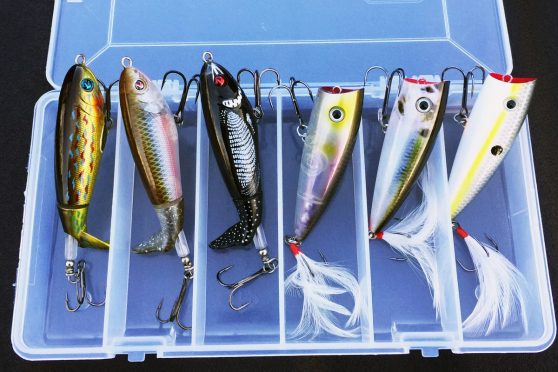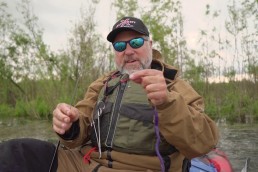‘Go-two’ Topwater Baits
SHARE THIS POST
Reflecting back on my early years of on-the-bank bass chasing, from thumbing that button on my Zebco 33 and Johnson Century to laying that Hula Popper and Jitterbug right in front of ol’ bucketmouth’s lair, I must confess to having a topwater addiction.
Though my equipment and baits have evolved tenfold since those early days, the sheer adrenaline rush of experiencing a bass blow up on my topwater has yet to dwindle with the passing years. That explosive surface reaction when a bass is all over your bait removes any pondering as to the possibility of a hit. No other bait makes that visual connection between you and your quarry like the surface bait can.
In today’s bass fishing, there is a multitude of topwater options available. For this “Bassin’” article our focus will be directed toward just two baits—the two that during spring will accompany me on every shoreline I choose to wander down

We’ll explore those and the reasons why in a moment. But here’s a side note to this article and future articles for this column that matter. Please note that when I focus on various baits, tackle or technique selections, these topics are based on my personal experience with that tackle or approach. While tackle choices abound, there is one disadvantage, or maybe just a limitation for the bank-fishing basser, and that’s portability. You can only carry so much tackle, so my intention is to narrow down some choices to a couple advanced, proven techniques. My hope is that you find some that fit into your style of bass fishing.
So, back to my list of topwater baits. We’ll be tying the Palomar knot on these. Bait number 1 will be a popper-type bait and Bait 2 will be a prop-type bait, more specifically the Whopper Plopper. Though both are hard-bodied surface baits, both have quite different characteristics once on the water.
Now most of you are probably familiar with these types of baits, but coming away from another outdoors show season, I met quite a few new bank bassers who are exploring more advanced bass-fishing techniques. My goal or purpose for all that I write is to teach; it’s to share information that might increase someone’s chances for a successful outing. So, bear with me for a moment.
Let’s take a look at Bait 1: the popper.
Poppers are normally a hard-bodied bait. While there are a few soft-bodied styles floating around out there mixed with some weedless frogs with popping mouths, for this article I’m sticking with the standard popper. The unique design of the popper is the concave face or mouth section of the bait. When worked properly, the flat, yet concaved curve of its face will splash or spit water forward, creating this signature action. The actual design of this bait’s face will vary from one manufacturer to the next, giving each its own style of surface disturbance. Sporting two sets of trebles, I prefer ones with dressed or feathered tail hooks.
A look at Bait 2: the Whopper Plopper.
This prop bait hit the market a few years back with quite the splash. I’ve been using them since they hit the shelves with incredible success. River2Sea’s Whopper Plopper 90 has been for sure one of my go-to baits the last couple of years. So much so, that I have even on occasions have had to leave it home to prevent myself from reverting back to it when things slow with the other baits. Its unique spinning prop-tail design creates a unique sound and small wake that stirs up the bass from every body of water where it’s made a ripple. One thing to keep in mind is—even though it’s a topwater—if you pause your retrieve, the lure will sink.
Are you enjoying this post?
You can be among the first to get the latest info on where to go, what to use and how to use it!
With the basics of the lure design behind us, the next bit of information is regarding when to use these topwater baits from a seasonal standpoint. I’ll start using these once the water temperatures hit the mid-50s and will continue until late fall when the temperatures drop again. If finding the water temperatures of your favorite body of water is a challenge or impossible, just let nature show you the signs. Keep a watch on the shallows where you fish. When you start to see small bluegills and other small fish return to the skinny water, the surface baits usually become effective.
As far as where to use these topwater baits, my answer would be anywhere you cast a line for bass. I’ve used them on still waters and moving areas alike with much success, over the shallows of course, but they have been effective on calling up the deep-water bass. Here in late spring, emergent weeds are an awesome choice for both types of topwater baits. Always keep an eye out and watch for targets near the bank or just a ways offshore. Work not only the submerged weeds, but also the edges of weedlines that have arrived on the surface. Areas with wood are great targets and where it tangles a lot underneath. You can work these baits over some thick bottom debris as well—areas that would be a snagfest for other baits. Your only limitation would be if the weeds have choked the surface, and with these baits dangling treble hooks from below, where you’d be constantly fouled.
Let’s go over some bait presentations.
For the popper-type bait—and this is why I like fishing them—you have to make the bait work. You have to figure out the right speed and cadence of your popping action to draw bass into attacking your bait. Other baits do much of the work to attract bass, but this one is on you, my friend. Now, another critical tip here is to never just pop this bait back to you in a constant rhythm. Make that bait dance on top with quick snaps with the rod tip, followed by pauses, almost deadsticking the bait at times. An irregular retrieve will generate most of your strikes. Get creative with your retrieve, and since this bait floats at rest, make sure you pause it over underwater structure.
Now for the Whopper Plopper: I can cover an enormous amount of shoreline with this bait. As mentioned earlier, this choice will sink at rest so you have to keep the Plopper moving. This prop bait, though a true surface lure, becomes more like a searching crankbait presentation than a traditional topwater technique. When I’m trying to locate active fish and need to cover quite a bit of ground in the process, I break out the Plopper. Like the popper above, work this bait over underwater structure and emerging weeds.
Since we are on the topic of presentation, let me give you a brief idea to kick around since you decided to read this far. As a bank-fishing bass angler and bank angler in general, focus on the water in your effective reach zone with your bait presentations, and no farther. I know many bank anglers become intimidated sometimes by the size of some bodies of water. You can only cover from the bank in say, “50-75 feet out.” Yes, I know you can make longer casts, but the effectiveness of some presentations and hook-sets drop significantly beyond these ranges. So, fish the bass right in front of you. I can’t tell you how many 5-plus-pound bass I have taken from within a rods-length distance from shore. If you’re still not sold, watch some of the major bass tournaments and the pros pluck bass right out of “your” domain. We’ll talk another time on close-proximity bassing.
Quick—before I run out of column, which is normal for me: the color. You will find I don’t invest a whole lot of thought into my color selection for baits. Just get some natural shad and bluegill patterns and a black bait for an extremely low-light condition. We’ll save the color debate for another time.
As far as rods, reels and line, check out the “Bassin’ Gear Review” info outside this column. But, as always, use what you have.
I want to thank you for taking the time to read this first of many articles exploring advanced bank-fishing techniques for bass. I enjoy and get pumped sharing my bass-fishing experiences. But please do me a huge favor and take a minute to share with me an email on your bass-catching stories by boat or on a stretch of bank.
MWO
SHARE THIS POST
Did you enjoy this post?
You can be among the first to get the latest info on where to go, what to use and how to use it!
Dan Brozowski
Passion for angling drives Dan Brozowski to the water’s edge virtually any chance he gets. Although passion cannot be measured, weighed, or recorded, it can be shared. He does this through his writing and while on the water. If you have any questions or comments for Dan, you may contact him at: onthebank@att.net.



